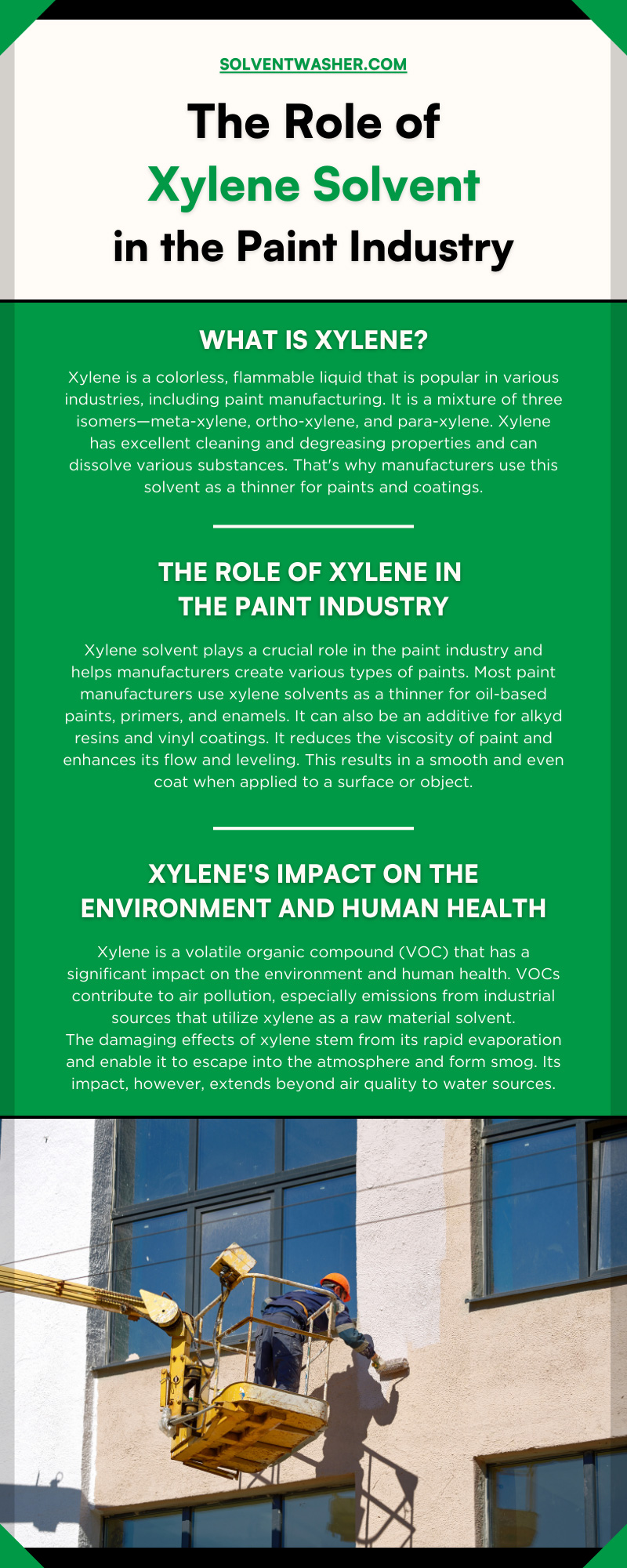Paint is important for residential and commercial structures. It serves as a protective layer for surfaces and adds to the aesthetic appeal of a building. Paint manufacturing involves the use of chemicals like solvents. A prominent solvent in the paint industry is xylene, and it’s important to understand the role of xylene in the paint industry and its impact on the environment.
What Is Xylene?
Xylene is a colorless, flammable liquid that is popular in various industries, including paint manufacturing. It is a mixture of three isomers—meta-xylene, ortho-xylene, and para-xylene. Xylene has excellent cleaning and degreasing properties and can dissolve various substances. That’s why manufacturers use this solvent as a thinner for paints and coatings.
Properties of Xylene
Xylene has several properties that make it an ideal solvent for the paint industry:
- A high solvency power means xylene can dissolve many substances, including resins and pigments used in paint production.
- A low boiling point lets xylene evaporate quickly, making it an ideal solvent for quick-drying paints.
- A high flash point means xylene is less likely to ignite or explode when exposed to fire or heat.
The Role of Xylene in the Paint Industry
Xylene solvent plays a crucial role in the paint industry and helps manufacturers create various types of paints. Most paint manufacturers use xylene solvents as a thinner for oil-based paints, primers, and enamels. It can also be an additive for alkyd resins and vinyl coatings. It reduces the viscosity of paint and enhances its flow and leveling. This results in a smooth and even coat when applied to a surface or object.
Xylene is also crucial in the production of automotive and industrial paints. It helps to dissolve the resins and pigments in paints, providing a smooth finish and long-lasting shine. Lastly, the use of xylene solvents in paints is particularly prominent in the manufacturing of spray paints and coatings that go on as thin layers.
Xylene’s Impact on the Environment and Human Health
Xylene is a volatile organic compound (VOC) that has a significant impact on the environment and human health. VOCs contribute to air pollution, especially emissions from industrial sources that utilize xylene as a raw material solvent.
The damaging effects of xylene stem from its rapid evaporation and enable it to escape into the atmosphere and form smog. Its impact, however, extends beyond air quality to water sources. When manufacturers improperly dispose of xylene paint solvents, it can easily leach into the soil and groundwater. Because xylene is derived from petroleum, its presence in the environment can cause long-term damage. Inhaling xylene vapors can lead to dizziness, headaches, and respiratory issues.
Mitigating the adverse effects of xylene requires people to follow safe disposal practices. Awareness of the environmental and health implications of xylene can promote the responsible use of this substance.
How To Reduce the Impact of Xylene Solvent
It’s important to prioritize and address the environmental impacts of xylene solvent. Here are several practices that paint manufacturers can follow to mitigate xylene’s adverse effects and preserve the environment:
Use Low-VOC Paints
Using low-VOC paints can reduce the environmental impact caused by xylene solvent. Low-VOC paints are water-based and formulated with fewer solvents than traditional paints with high levels of VOCs.
As a result, low-VOC paints emit fewer fumes and are less detrimental to the environment and human health. By opting for these paints, manufacturers can promote better air quality.
Citrus-Based Solvents
Citrus-based solvents come from orange, grapefruit, and lemon peels. They are less toxic alternatives to xylene solvents and have a sweet, fruity smell that is less noxious than solvent-based paints. Citrus-based solvents do not contain VOCs, making them environmentally friendly.
Acetone-Based Solvents
Acetone is a colorless, volatile liquid that is a popular alternative to xylene. Acetone is not harmful to the environment or human health and is a good cleaner for surfaces. However, acetone can evaporate very quickly, so it is not suitable for all types of paint.
Oxygenated Solvents
Oxygenated solvents contain ketones, esters, ethers, and alcohol. These solvents have a high boiling point and low toxicity levels, allowing them to work well in latex, acrylic, and enamel paint formulations. They are good alternatives to conventional solvents, as they have low VOC levels and are eco-friendly.
Recovering Solvent
Solvent recovery is the process of reclaiming and reusing solvents from industrial processes. It involves separating the solvent from impurities and distilling it to its original state. This process enables paint manufacturers to reuse solvents in production processes.
Recycling xylene through solvent recovery minimizes the environmental impact of paint waste and reduces the amount of hazardous waste that paint manufacturers generate.
Depending on the size of the paint manufacturing facility, paint producers can implement different solvent recovery systems. For instance, the 30-gallon solvent recycler is ideal for mid-sized facilities. Additionally, 55 and 70-gallon machines are ideal for larger operations.
Besides their environmental benefits, solvent recyclers can help paint manufacturers save money because they don’t have to purchase new xylene for their processes.
Disposal of Paint Waste
It’s best to adhere to the regulations established by local and state authorities regarding the handling, storage, transportation, and disposal of paint waste. By meticulously following these regulations, paint manufacturers can protect the environment and their reputations.
Some popular disposal methods include treatment processes to neutralize hazardous components before disposal. This ensures the waste does not pose a risk to the environment or human health. For example, solidifying agents can turn wet paint into solids so they’re easier to throw away.
Furthermore, a professional hazardous waste facility can pick up paint waste. Hazardous paint waste includes heavy metals and solvents. Manufacturers can contact their local waste management organization to schedule a pickup.
The Use of Sustainable Paint and Raw Materials
Using raw materials in sustainable paint is a crucial and effective step in minimizing the environmental impact of xylene solvent. By utilizing organic pigments and raw materials in paint production, manufacturers can reduce their reliance on xylene and other hazardous solvents.
This shift toward eco-friendly alternatives not only enhances the sustainability of the paint industry, but it also contributes to the preservation of the environment and human health.


